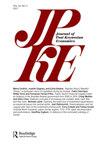重新思考21世纪的不平等——金融化经济体中的不平等与家庭资产负债表构成
IF 1
3区 经济学
Q4 ECONOMICS
引用次数: 1
摘要
摘要本文分析了金融化经济中家庭财富异质性对不平等和宏观经济稳定的影响。基于20世纪80年代以来美国的情况,它认为金融部门运营的转型通过影响财富所有权的收益和整个收入分配的杠杆水平而产生了不平等。证券化和次级贷款扩张导致了一类新的杠杆房主的出现,他们在大衰退前经历了财富的大幅增长,在危机后又遭受了巨大损失。与此同时,资本家在担任金融部门高管时,实现了资产组合的多元化,同时获得了经济中最高、增长最快的工资。有鉴于此,本文提出了宏观经济模型中家庭的新概念,由资产负债表组成而非收入来源单独定义。为了说明这一分类法,在一个根据美国数据校准的股票流一致性模型中模拟了不平等和杠杆指标,其中包括三类按财富构成区分的家庭,以及一个证券化的金融部门。与两个阶级划分相比,所提出的框架产生了更准确的收入不平等水平和更大的宏观经济不稳定性,并建立了住房对财富分配的均衡效应。本文章由计算机程序翻译,如有差异,请以英文原文为准。
Rethinking inequality in the 21st century – inequality and household balance sheet composition in financialized economies
Abstract This paper analyses the impact of household wealth heterogeneity on inequality and macroeconomic stability in financialized economies. Based on the case of the USA since the 1980s it argues that transformation of financial sector operations has generated inequality by influencing gains from wealth ownership and leverage levels across the income distribution. Securitization and the subprime lending expansion have led to the emergence of a new class of leveraged homeowners, experiencing large increases in wealth prior to the Great Recession, followed by substantial losses after the crisis. Simultaneously, capitalists have diversified their asset portfolios while earning the highest and fastest-growing wages in the economy when employed as financial sector executives. In this light, the paper proposes a new conceptualization of households in macroeconomic models, defined by balance sheet composition rather than income sources alone. To inform this taxonomy, inequality and leverage indicators are simulated in a stock-flow consistent model calibrated to US data with three classes of households distinguished by their wealth composition, and a securitized financial sector. The proposed framework is found to produce more empirically accurate levels of income inequality and greater macroeconomic instability than the two-class division and establishes an equalizing effect of housing for wealth distribution.
求助全文
通过发布文献求助,成功后即可免费获取论文全文。
去求助
来源期刊

Journal of Post Keynesian Economics
ECONOMICS-
CiteScore
1.70
自引率
10.00%
发文量
23
期刊介绍:
The Journal of Post Keynesian Economics is a scholarly journal of innovative theoretical and empirical work that sheds fresh light on contemporary economic problems. It is committed to the principle that cumulative development of economic theory is only possible when the theory is continuously subjected to scrutiny in terms of its ability both to explain the real world and to provide a reliable guide to public policy.
 求助内容:
求助内容: 应助结果提醒方式:
应助结果提醒方式:


